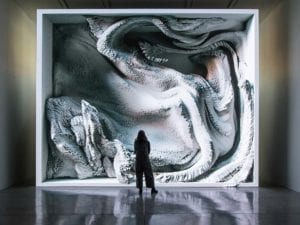Sensitive to ecological issues, visual artist Brigitte Amarger, based in Paris, France, creates artworks by recycling discarded materials, in an eco-responsible zero waste approach. Her practice includes textile and digital techniques, laser cutting and engraving on x-ray, luminescent and reflective media, textile and paper. Her sculptural installation La Chute / The Fall (2021) is composed of discarded materials, rendering them into little cut-outs of falling figures. The work, shortlisted for the Aesthetica Art Prize 2024 sits at the centre of York Art Gallery’s space, dazzling viewers in its iridescent, and dynamic command of space. Amarger questions the use of communicating, connected textiles, which integrate technology requiring a source of energy, and the limits of this relationship. Here, we speak to the artist about her practice.

A: Recycling and ecological sensitivity are key to your practice. Can you tell us about the materials you choose to use, and where they come from?
BA: My primary source of inspiration stems from nature, as I am drawn to collecting natural elements that ignite my creativity and find their way into my artistic endeavors. The devastating effects of natural disasters, especially those linked to the Anthropocene era, has also fueled my artistic expression. Often, I incorporate materials such as barks and charcoal into my work, symbolising the impact of human devastation on the environment and prompting viewers to contemplate our collective responsibility.
In our fight against the plastics that are invading our planet, I have collected many X-rays from hospitals and individuals. By juxtaposing these images of the human body, a symbol of fragility and impermanence, with motifs from botany, entomology, and endangered species, I aim to underscore the interconnectedness between humanity and the natural world. Using recovered textile samples, I question the second life of discarded materials, changing their initial status as waste, transforming them and valorising them through an artistic action that gives them a new lease of life. In a society where production has become synonymous with destruction, I also claim an eco-responsibility that aims for zero waste by reusing, as much as possible, those of my works.

A: What does the process of installing a work like La Chute look like? Is it delicate, and are there a lot of moving parts?
BA: The silhouettes are arranged and attached to nylon threads, categorized by material – such as paper, tracing paper, or x-ray bodies – and size: small, medium, or large. The intention is to suspend them from a supporting structure that seamlessly blends into the ceiling. This structure could consist of a frame, white bars, or a network of nylon threads, discreetly integrated to create the illusion that the figures are descending from the sky. To enhance the effect, shorter threads are included to allow the bodies to gently rotate. Those resting on the ground are static. A place with air currents should obviously be banned!
A: Your pieces are so intricate. How long do they typically take to create, and what stages of production are involved?
BA: First, I draw the silhouettes, and select the most appropriate for their movement. Then I choose the media, the thickness and type of papers, as well as the type of X-rays – more or less transparent. I plan on the computer. Do tests. Engrave and / or laser cut the figures. Remove the silhouettes from their support. Sort them by category and size. Assemble them. Test the effect obtained. Then I find a way of storing the pieces to avoid any tangling and reduce the volume of the installation so it can be set up easily. I am passionate and I never count my time!

A: If our audiences could only take one thought – or feeling – away from your work, what would it be?
BA: The poetic, meditative, contemplative aspects of the work. Its airy lightness. Its aesthetics which allows us to dream and escape, at first, but which on further inspection, reveals the weight of sensitive and serious subjects, belonging to the sad reality of our society, and on which we must question and reflect.
A: What does it mean to be an Aesthetica Art Prize Finalist?
BA: I am very grateful to be one of the artists selected for this prize. The awarding of a recognised award or prize, given by professionals, demonstrates the quality and consideration of your work, and even your career. I am honoured and warmly thank the jury for also giving me the opportunity to install my work in this beautiful gallery. I always look forward to see the reactions of the public and exchanging with them their perception of my work. This has also allowed me to come again to England and to meet other artists and hear the points of view of the Symposium speakers on topics that are close to my heart.
Amarger features in the Aesthetica Art Prize 2024 Exhibition at York Art Gallery from 16 February – 21 April. Plus, meet over 250 longlisted international artists in our new online gallery.
Want to get involved? The next edition of the Prize is open for entries. Submit your work by 31 August. Win £10,000, exhibition and publication. Find out more here.
All images courtesy of Brigitte Amarger.





